Posts by: Sarah Tesh
Cat-chy quantum song, science TV resurrected, $800,000 textbook, desk traffic lights
By Sarah Tesh
I never realized it until now, but my life was missing a song about Schrödinger’s cat. Well, theoretical physicist, science writer and now singer/song writer Sabine Hossenfelder has come to the rescue with a song about quantum states. This is her second music video done in collaboration artists Apostolos Vasilidis and Timo Alho. The rather cat-chy tune not only includes lyrics about quantum entanglement, Boltzmann brains and the multiverse, but also fits in references to Star Trek and The Matrix. In her BackReaction blog, Hossenfelder says, “If you think this one’s heavy on the nerdism, wait for the next.” We’re looking forward to it!
View all posts by this author | View this author's profile
Cassini’s emotional countdown, Steve the light show, shooting hoops ‘granny style’
By Sarah Tesh
This week has seen the beginning of Cassini’s Grand Finale. The rather dramatically named final mission for the NASA spacecraft involves 22 dives between Saturn and its surrounding rings. Once complete, Cassini will crash into the planet’s atmosphere in what the scientists hope will be a flurry of data gathering. The spacecraft has already sent back stunning images of storms in Saturn’s atmosphere from its first dive on 26 April. After 20 years since its launch, the mission to Saturn’s system has been a masterclass in space exploration, and NASA highlights the best bits in this theatrical video. The short film, reminiscent of Star Trek, could be considered a bit cheesy, but it’s hard not to form an emotional attachment to NASA’s loyal Cassini as you join in the countdown to its final demise.
View all posts by this author | View this author's profile
Snooker cues, negative mass, apps for waiting and CERN croissants
By Sarah Tesh
With the World Snooker Championship taking place at the moment, it’s that time of year when those of us who are usually snookered by the game are suddenly in its pockets. Right on cue, Phil Sutton from Loughborough University in the UK helps bridge the gap between science and snooker. In his video big break, he looks at why players use chalk on their cue tips. Interestingly, there is a right way to help you spin out a 147 and a wrong way that could leave you pocketing the white.
View all posts by this author | View this author's profile
NanoCars race on gold, sketchers invade Fermilab, physics of Thor versus the Hulk
By Sarah Tesh
Science has taken motor racing to a whole new, extremely small level with the NanoCar Race. The competition on 28 April will see nanoscale molecular machines “speed” around a gold racetrack for 38 hours. As the tiny-molecule cars are not visible to the naked eye, the race will take place inside a scanning tunnelling microscope (STM) at the Center for the Development of Materials and Structural Studies (CEMES), part of the National Center for Scientific Research (CNRS) in France. The teams behind the NanoCars control their vehicles using electric pulses but are not allowed to push them mechanically. Details about the cars and their teams can be found on this website, where you will also be able to watch the race later this month. There is more about the competition in the above video.
View all posts by this author | View this author's profile
Einstein world record, Spider-Man physics, quantum films and cakes
By Sarah Tesh and James Dacey
A world-record-breaking hoard of Albert Einsteins invaded Toronto in Canada on Tuesday 28 March. 404 people gathered in the city’s MaRS Discovery District dressed in the genius’s quintessential blazer and tie, and sporting bushy white wigs and fluffy mustaches. As well as breaking the previous Guinness World Record of 99 Einsteins, the gathering kicked off this year’s Next Einstein Competition. The online contest invites the public to submit ideas that can make the world a better place and awards the winner $10,000 to help them realize it.
View all posts by this author | View this author's profile
Quantum punchlines, the cloud atlas, NASA schooled
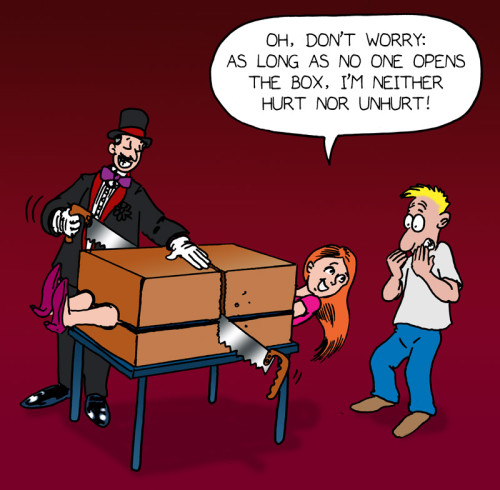
Quantum humour: is the joke dead or alive? (Creative Commons/Benoît Leblanc)
By Sarah Tesh
You may not normally associate humour with quantum theory, but it’s not just jokes about Schrödinger’s cat and Heisenberg’s uncertainty principle that links the two. Liane Gabora of the University of British Columbia in Canada and Kirsty Kitto of Queensland University of Technology in Australia have created a new model for humour based upon the mathematical frameworks of quantum theory. The idea for their “Quantum Theory of Humour” stems from jokes like “Time flies like an arrow. Fruit flies like a banana.” Separately, the statements aren’t amusing but together they make a punchline. This requires you to hold two ideas in your head at once – a concept analogous to quantum superposition.
How LIGO got the word out about gravitational waves
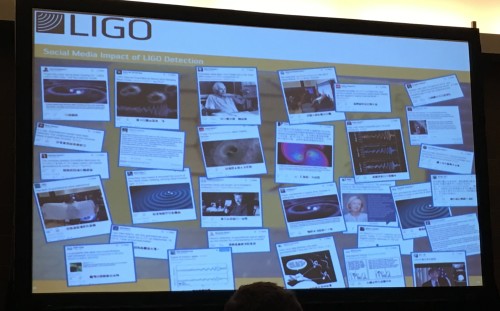
Tweeting to millions: LIGO made a social-media plan before announcing the detection. (Courtesy: Sarah Tesh)
By Sarah Tesh
Nowadays, social media plays a big role in communicating science to the public. It has two important qualities – it’s free and it’s international. A great case study for social media and science came last year when the Laser Interferometer Gravitational-Wave Observatory (LIGO) announced the first ever detection of gravitational waves. To tell us more about how the team grabbed the public’s attention (and got its work on Sheldon Cooper’s T-shirt in The Big Bang Theory), LIGO scientist Amber Stuver gave a witty talk at the APS March Meeting 2017 about the outreach strategy.
She began by telling us the story of that exciting detection day. Before the first detection, LIGO had published 80 papers on “detecting nothing”. Yet on 14 September 2015 – the first morning of the first day of Advanced LIGO – the much-sought-after signal appeared. The first thing that had to be done was to check it wasn’t a fake. Having detected nothing for so long, those with the knowledge to do so would sometimes “inject” results to check the system worked and keep the scientists on their toes.
View all posts by this author | View this author's profile
Physics reveals the mysteries behind art
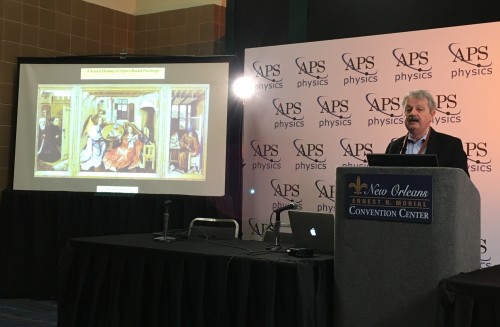
Artists’ secrets: Charles Falco describes how artists used optical lenses. (Courtesy: Tushna Commissariat)
By Sarah Tesh in New Orleans, Louisiana, US
As a physicist who likes to sketch and paint, I love it when art and physics come together. I was therefore excited to see that the APS March Meeting had a variety of talks on the subject. Charles Falco from the University of Arizona in the US told us about his work with the famous artist David Hockney. On a trip to see the 15th century painting The Arnolfini Marriage by Jan van Eyck, Hockney decided that the chandelier was too detailed to have been done freehand. So Falco and Hockney began looking at the intricate parts of paintings by artists through the ages and found that they essentially cheated.
Through focal length and depth-of-field calculations, Falco showed that artists had used optical lenses to project the complicated parts onto the canvas before painting them. They suggest that this has been happening since the 1400s and is a technique used by artists such as Hans Holbein (who painted the iconic portraits of Henry VIII) and Johannes Vermeer (whose work includes Girl with a Pearl Earring). Obviously, they still possessed huge amounts of skill, but it definitely makes me feel a bit better about my own skill level.
View all posts by this author | View this author's profile
Invisible robots overshadowed by metallic hydrogen
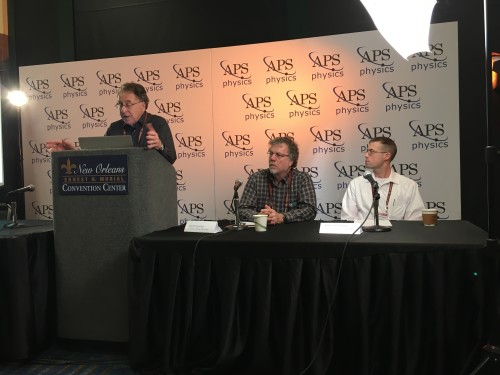
Metallic debate: Silvera, Ceperley and McMahon discuss metallic hydrogen. (Courtesy: Sarah Tesh)
By Sarah Tesh in New Orleans, Louisiana, US
After much coffee and a lot of crispy bacon, the second day of the APS March Meeting began. The hot topic of the day – metallic hydrogen. Even though we arrived 15 minutes early to Isaac Silvera‘s talk, the crowd was overflowing from the room, but despite all the pushing and shoving (my foot has not recovered from being stood on), we did manage to get seats. Silvera began by saying that he had been working on the problem for “probably longer than [most of us] were born” before taking us through the nearly 45 years of research on the subject. He also gave a press conference that included talks by theoretical physicists David Ceperley from the University of Illinois and Jeffrey McMahon from Washington State University. My colleague Tushna Commissariat caught up with Silvera later on, so be on the lookout for a more detailed update from her.
View all posts by this author | View this author's profile
APS sees friction as fracture, cat pictures and brain implants
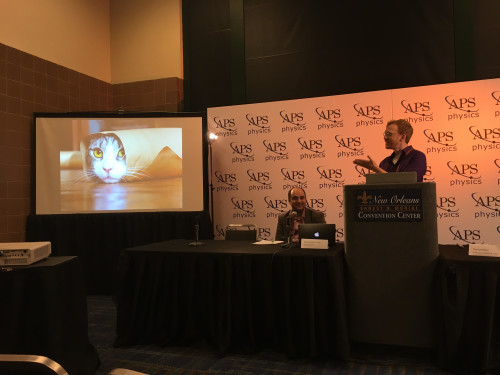
Cats and DFT: Thomas Baker chats about machine learning and density functional theory. (Courtesy: Sarah Tesh)
By Sarah Tesh in New Orleans, Louisiana, US
So the first day of the APS March Meeting has been and gone and the second is nearly at an end. Being my first conference as a journalist not a scientist, I was definitely as nervous as some of the speakers looked. The conference centre is huge, there are thousands of people and almost as many talks – a rather daunting prospect for a newbie. Thankfully there were some very interesting press talks, covering a variety of topics.
The first session began with Jay Fineberg from the Hebrew University of Jerusalem in Israel talking about “friction as fracture”. While we all learn about friction at school, the fundamental physics behind it remains shrouded in mystery. So Fineberg looks at the problem as the fracture of contact points. This approach makes it particularly useful for studying the motion of tectonic plates and, so, earthquakes. As Fineberg points out, seismologists have no idea about conditions deep in the ground at a fault. He and his team therefore hope to work out “what makes earthquakes tick”.
View all posts by this author | View this author's profile